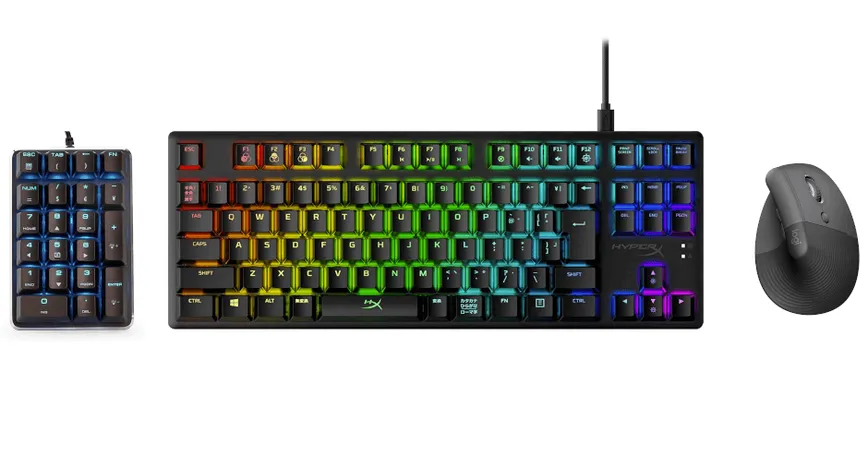
How to overcome the weaknesses of a full-size keyboard with a left-handed numeric keypad
A numeric keypad is useful when numbers are used frequently. However, a full-size keyboard has some disadvantages, such as being too far away from the mouse and taking up too much width at your desk. In this article, we will show you how to overcome the weaknesses of a full-size keyboard by using a tenkeyless keyboard and a left-handed numeric keypad.
Modified at: 2023.2.9Posted at: 2022.8.10
Weaknesses of full-size keyboards and advantages of tenkeyless keyboards
The full-size keyboard is the standard keyboard of choice for desktop PCs. However, full-size keyboards have some layout disadvantages.
- the mouse is far to the right relative to the center position
- more desk space is needed on the right side to accommodate the center position
Especially for those who do a lot of typing at work or gamers who continuously type multiple keys, the ability to take the center position when typing is a surprisingly big concern because it directly affects not only typing speed but also physical pain such as neck and shoulder pain.
On the other hand, a tenkeyless keyboard allows the mouse to be placed on the numeric keypad, so typing can be done in a style closer to the center position than with a full-size keyboard.
Compact keyboards, such as 60%, are best for desk width, but they are not universal, since arrow keys and page-movement keys are assigned in combination with Fn.
Advantages and disadvantages of tenkeyless keyboard + left-handed numeric keypad
Symmetrical layout can be created by utilizing the space on the right side of the keyboard.
With a left-handed numeric keypad, you can create a symmetrical layout with the numeric keypad on the left and the mouse on the right, in relation to the center position of the keyboard. This reduces the burden on the user's body because there is no unnecessary movement to the left or right when typing or using the mouse.
If an external numeric keypad is used, it can be moved to the front to avoid keystroke errors, increasing the flexibility of the layout.
Risk of failure can be spread out.
Except for those who do not use the numeric keypad very often, for users who often use numbers in their work, there are many cases where the numeric keys are often hit more often than the letter keys.
If a full-size keyboard is used, if any key on the numeric keypad malfunctions, the entire keyboard will have to be repaired or replaced.
Left thumb to enter.
One disadvantage is that the Enter key is assigned to the left thumb.
The normal numeric keypad has the Enter key placed in the lower right corner, so it is usually typed with the little finger, which is the same as the main Enter key. Since we instinctively remember "Enter with the left pinky," a thumb Enter would be uncomfortable.
If you are not used to it, you can solve this problem by placing it on the right side of the keyboard as you do with a full-size keyboard.
Wiring is messy.
Unless you are using a wireless keyboard such as Bluetooth, if you are using a wired keyboard, the wiring on your desk will become cluttered because of the additional distribution lines for the numeric keypad.
We have looked at the use of left-handed numeric keypad and numeric keyless keyboard.
Although this method is not the best for everyone and is "for users who use the numeric keypad frequently," it is good to know as one of the factors to consider when choosing the size of an expensive keyboard.